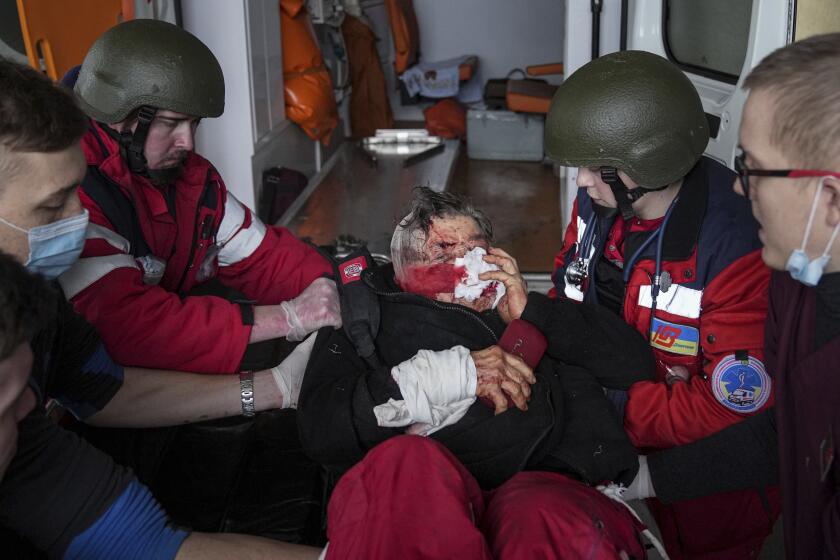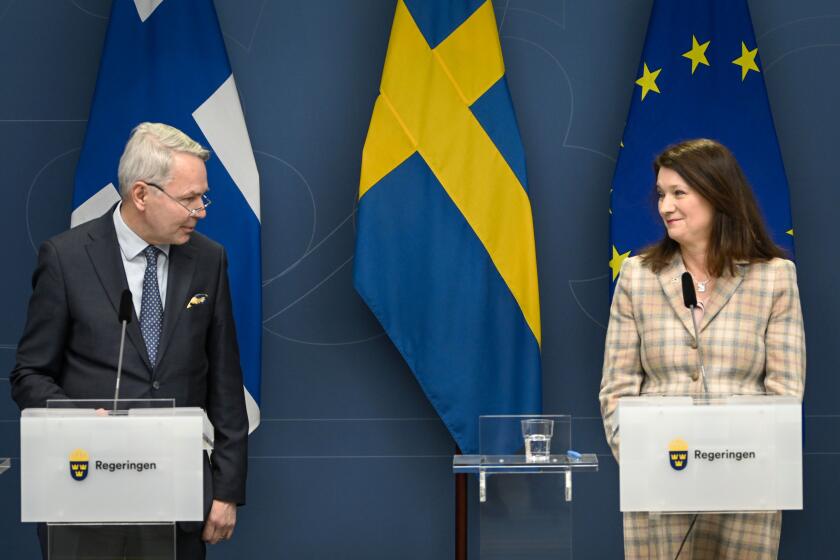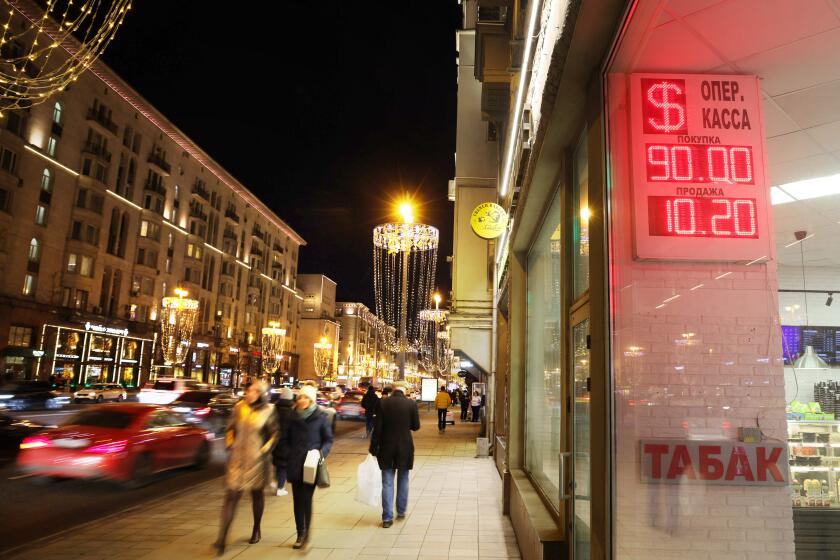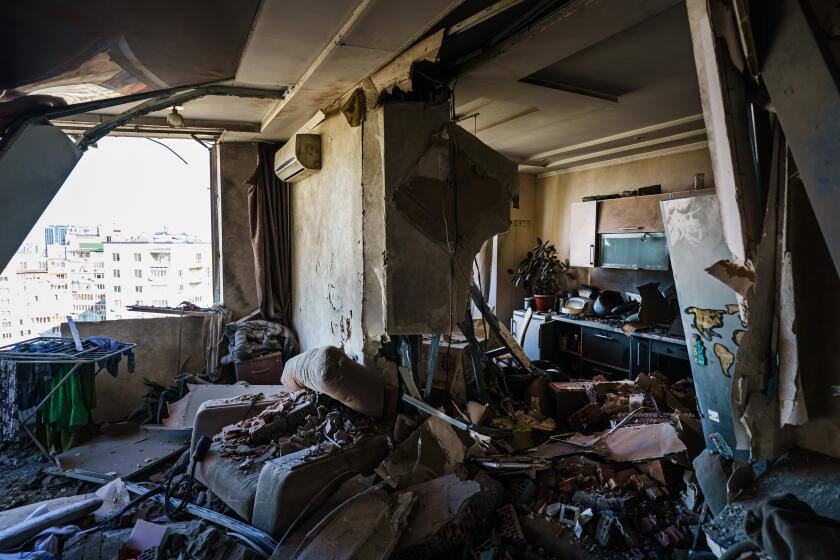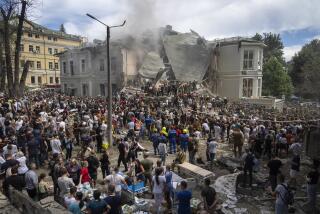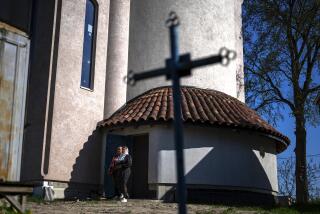Fears rise for Kyiv’s centuries-old Christian shrines and other symbolic landmarks
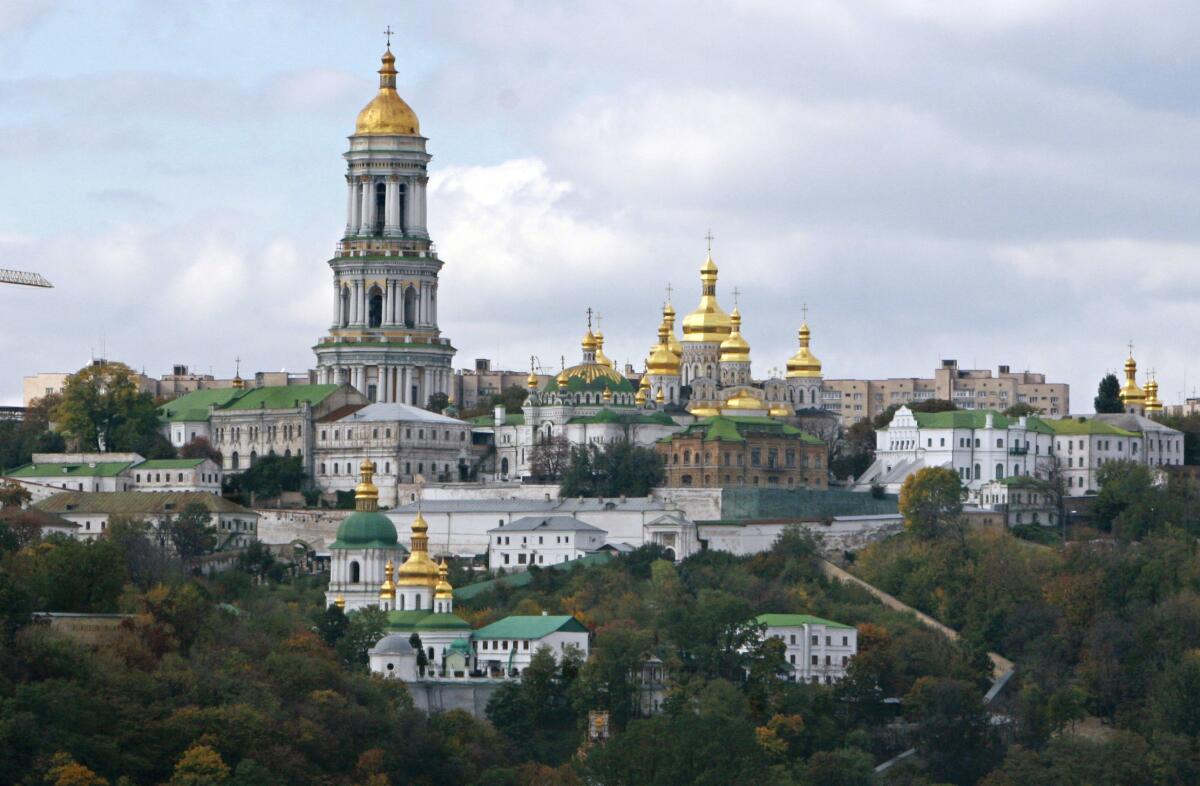
- Share via
Kyiv, which is bracing for a potentially catastrophic Russian attack, is the spiritual heart of Ukraine.
Among the sites at risk in the Ukrainian capital are the nation’s most sacred Orthodox shrines, dating back nearly 1,000 years to the dawn of Christianity in the region.
The sites, along with other landmark shrines in Kyiv, hold religious significance for both Ukrainian Orthodox and Russian Orthodox believers. They also stand as powerful symbols in the quarrel over whether the two groups are parts of a single people — as Russian President Vladimir Putin has claimed — or are distinct but related Slavic nations.
The landmarks include the golden-domed St. Sophia Cathedral and the Kyiv-Pechersk Lavra, a sprawling underground and aboveground complex also known as the Monastery of the Caves. Others include the multi-towered St. Michael’s Golden-Domed Monastery and St. Andrew’s Church.
On Tuesday, Ukrainian officials said Russian forces damaged another monument — the nation’s main Holocaust memorial, Babyn Yar — prompting international condemnation.
“What will be next if even Babyn Yar” is hit, Ukrainian President Volodymyr Zelensky said Wednesday. “What other ‘military’ objects, ‘NATO bases’ are threatening Russia? St. Sophia’s Cathedral, Lavra, Andrew’s Church?”
A fire in a Ukrainian nuclear reactor has been extinguished, radiation levels remain normal and the plant is in the hands of Russian forces, authorities say.
There is no indication the Russians intentionally targeted Babyn Yar. Nor is there any confirmation that the Russians plan to target any of the sacred sites in Kyiv. But civilian buildings have already been hit in other cities, and Kyiv’s major shrines sit in elevated locations that could leave them especially vulnerable.
Case in point: The Assumption Cathedral in Kharkiv, Ukraine’s second-largest city, was damaged in the recent attacks, reportedly with stained-glass windows shattered and other decorations damaged. The cathedral, which is under the Moscow-affiliated Orthodox church, was Kharkiv’s tallest building until sometime in the 21st century.
The risk is even greater in Kyiv.
“We’re talking about a very old city,” said Jacob Lassin, a postdoctoral researcher at Arizona State University’s Melikian Center for Russian, Eurasian, and East European Studies. “The center part is densely packed. Even if you’re trying to hit one thing, you could easily hit something else.”
Through the Cold War and the decades since, nothing could persuade Finns and Swedes that they would be better off joining NATO — until now.
The symbolic value of the shrines is powerful even to people who don’t share the religious faith they commemorate.
“The idea that the main symbol that stood in your city for 1,000 years could be at risk or could be destroyed is very frightening,” Lassin said.
The symbols matter not only to the Ukrainian people but to Putin too. He justified the invasion with baseless claims that he was countering “neo-Nazism” in Ukraine — even though Zelensky is Jewish.
Babi Yar, a ravine in Kyiv, is where more than 33,000 Jews were killed within 48 hours in 1941 when the city was under Nazi occupation. The killing was carried out by SS troops along with local collaborators. It was one of the largest mass killings at a single location during World War II, according to the U.S. Holocaust Memorial Museum.
Even with the cratering ruble, Hollywood movies on hold and snarled metro payments, Putin still holds sway among many Russians despite sanctions.
It is “at once an accursed and a sacred place,” American Jewish Committee Chief Executive David Harris said. Just last year, Zelensky took part in the inauguration ceremony of a memorial there.
Whether Kyiv’s Orthodox shrines come under direct attack or suffer collateral damage, such an action would be a “total refutation” of another of Putin’s claims: to be defending Orthodox Ukrainians loyal to Moscow’s patriarch, Lassin said.
“It would literally be destroying the main seat of Russian Orthodoxy according to his own rhetoric,” Lassin said.
The shrines’ oldest parts date to the medieval Kievan Rus kingdom, soon after its adoption of Christianity under Prince Vladimir in the 10th century. Putin has claimed that the kingdom is the common ancestor of today’s Russia and Ukraine. Ukrainians counter that theirs is a distinct nation now under fratricidal attack from its Slavic neighbor.
Breaking News
Get breaking news, investigations, analysis and more signature journalism from the Los Angeles Times in your inbox.
You may occasionally receive promotional content from the Los Angeles Times.
The cathedral and nearby monastic complex represent “a masterpiece of human creative genius in both its architectural conception and its remarkable decoration,” says a summary by UNESCO, which lists them as World Heritage Sites.
The cathedral, built under Prince Yaroslav the Wise in the 11th century, was modeled after the Church of Hagia Sophia in Constantinople (now Istanbul), the spiritual and architectural heart of medieval Orthodoxy. The Kyiv cathedral includes mosaics and frescoes up to 1,000 years old, and it was a model for later churches in the region, according to UNESCO.
“The huge pantheon of Christian saints depicted in the cathedral has an unrivaled multiplicity among Byzantine monuments of that time,” UNESCO says.
The Monastery of the Caves, including underground monastic cells, tombs of saints and aboveground churches built across nearly nine centuries, was hugely influential in spreading Orthodox Christianity, according to UNESCO.
Russia now appears to be targeting government buildings and residential apartments, killing civilians and stirring chaos.
Both complexes were endangered and at times damaged by centuries of warfare.
St. Sophia, sacred both to Ukraine’s two main rival Orthodox churches and to Roman Catholics, is now a museum and isn’t normally used for religious services.
Two of the landmarks are associated with opposing sides in the schism within Ukrainian Orthodoxy.
The monastic complex is overseen by the Ukrainian Orthodox Church, which is affiliated with the Orthodox patriarch of Moscow, though it has broad autonomy. St. Michael’s is the base for the more nationalist Orthodox Church of Ukraine. But the Ukrainian leaders of both Orthodox groups have harshly criticized the Russian invasion.
If Kyiv’s landmarks are damaged or destroyed, “could it potentially damage morale? Yes,” Lassin said. “Could it potentially galvanize people to be more united? Absolutely. ... What I can say is the Ukrainian people are extremely resilient and are fighting back through all of this.”
More to Read
Sign up for Essential California
The most important California stories and recommendations in your inbox every morning.
You may occasionally receive promotional content from the Los Angeles Times.
